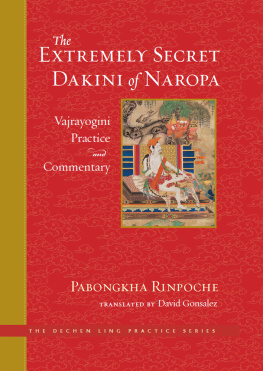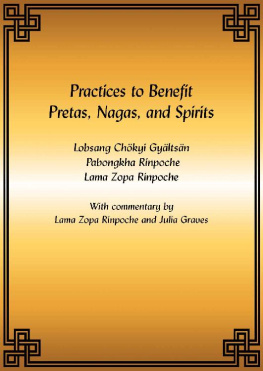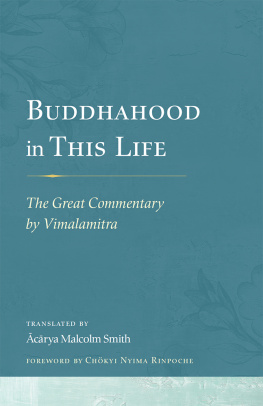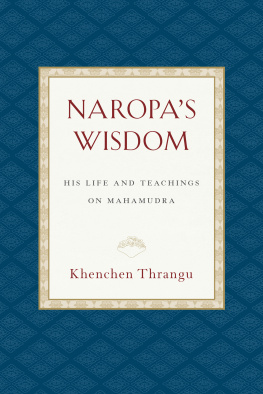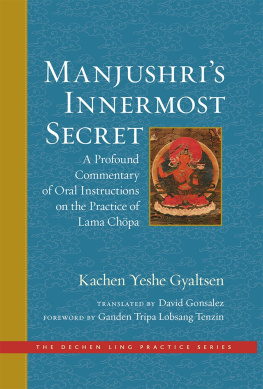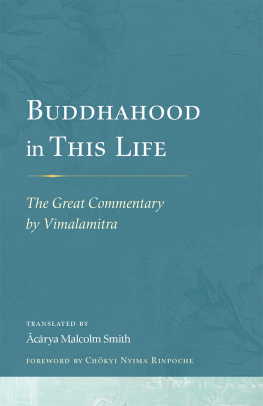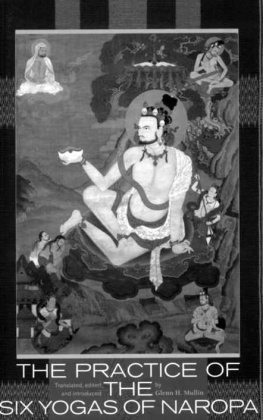A thorough and sparkling translation of an essential commentary on one of the most profound practices of Tibetan Buddhismthe practice of Vajrayogini, as composed by Kyabje Pabongkha Rinpoche and revealed to him directly by Vajrayogini herself.
Pabongkha Dechen Nyingpos works and teachings on Vajrayogini are based on his reception of the rare, restricted, golden lineage coming through the Sakya tradition. He also added up the exceptional qualities of Ganden Nyangys extraordinary methods of Jamgon Lama Tsongkhapa. As Pabongkha himself says, this Vajrayogini commentary is the fabric woven out of the cloth of Sakya and Gelugpa lamas together. This is a teaching that practitioners can use to transform themselves into a buddha, like the artists who shape beautiful images out of raw materials.
The translation of this was done by David Gonsalez under the instruction of Gen Lobsang Chophel, who happened to be one of the secretaries to the late H. H. Kyabje Trijang Dorjechang. It has to be perfect. Thank you for the publication of this wonderful translation; I strongly recommend authorized practitioners study this.
In translating this classic Tibetan guide on the meditative practice of Vajrayogini, as well as the sadhanas, into English, David Gonsalez has made important resources available to serious Vajrayana practitioners that would enrich their deep engagement with the Dharma. In this volume, the translator succeeds most admirably in capturing both the profundity and the liveliness of spirit that characterize the original Tibetan text of the famed Tibetan master Kyabje Pabongkha Rinpoche.
THUPTEN JINPA, principal translator to H. H. the Dalai Lama, whose translations include Mind Training: The Great Collection
Receive the latest news and updates from Wisdom, including new releases and special offers.
Click here to sign up.
Bibliography
Modern Texts
Geshe Acharya Thubten Loden. Path to the Union of Clear Light and Illusory Body. Melbourne: Tushita Publications, 2002.
Gray, David, trans. The Cakrasamvara Tantra. New York: American Institute of Buddhist Studies at Columbia University, 2007.
Hopkins, Jeffrey. Meditation on Emptiness. London: Wisdom Publications, 1983.
Kyabje Trijang Dorje Chang. The Ecstatic Dance of Chakrasamvara. Translated by David Gonsalez. Seattle, WA: Dechen Ling Press, 2013.
Mullin, Glenn H. Tsongkhapas Six Yogas of Naropa. Ithaca, N.Y.: Snow Lion Publications, 1996.
Nagarjuna. NagarjunasLetter to a Friend with Commentary by Kangyur Rinpoche. Translated by Padmakara Translation Group. Ithaca, N.Y.: Snow Lion Publications, 2005.
Ngulchu Dharmabhadra and the First Panchen Lama, Losang Chkyi Gyaltsen. Source of Supreme Bliss. Translated by David Gonsalez. Ithaca, N.Y.: Snow Lion Publications, 2010.
Stearns, Cyrus, trans. Taking the Result as the Path. Boston: Wisdom Publications, in association with the Library of Tibetan Classics, 2006.
Tibetan Texts
Ngagtsang Losang Tenpa Dargye. bDe chen dnos grub byung gnas [The Source of the Great Bliss Attainment].
Ngulchu Dharmabhadra. rNal byor mai bskyed rdzogs kyi zin bris mkha spyod bgrod pai gsang lam snying gi thig le [Notes on the Generation and Completion Stages of [Vajra]yogini Entitled The Heart-Drop of the Secret Path for Traversing to Dakini Land].
Yangchen Drupai Dorje. Na ro mkha spyod mai lam gyi smon la cha tshang bai tshig don lhug par bshad pa mkha spyod zhing du bod pai lhai rnga dbyangs [An Abundant Explanation of the Words and Meaning of the Entire Prayer for the Path of Naropas Power Goddess of Dakini LandJetsun VajrayoginiEntitled The Melodious Drum of the Deity Summoning One to Dakini Land].
1. The Yoga of Sleeping
ACCORDING TO the traditional system of explanation stemming from the first five great masters of the Sakya tradition, most of the subsequent commentators have said we must be awake to practice yoga, and before rising we must sleep, and it is for that reason that we begin with the yoga of sleeping. However, this is not the intention of the tantra, and a very special and profound sacred essential point of the oral instruction has not been revealed. Here, in the Geden Oral Lineage, the explanatory tradition accords with the intention of the tantra, which is that there is an extremely profound and essential reason why we begin with the yoga of sleeping. This will now be explained.
Mahasiddha Luipa has said,
During the day the Bhagavan vajra holder,
At night the yoginisso it is explained.
This is stated from the perspective of time. Furthermore, from the distinction of method and wisdom, this Mother Vajrayogini is a wisdom tantra. From the two, father and mother tantra, this is a mother tantra; from the two, appearance and emptiness, this is on the side of emptiness. The principal subject matter of mother tantra is the means of accomplishing the clear light of wisdom on the side of emptiness. If we combine appearance and emptiness, method and wisdom, illusory body and clear light, and the deity Father and Mother with the times of night and day, then from the distinction between appearance and emptiness, daytime is on the appearance side; from among method and wisdom, it is method; from among clear light and illusory body, it is the illusory body; from among the Father and Mother deities, it is the time of the Father. As for nighttime, from the distinction between appearance and emptiness, it is on the side of emptiness; among method and wisdom, it is wisdom; among the clear light and illusory body, it is the clear light; from among the Father and Mother deities, it is the time of the Mother. These are essential points for quickly generating realizations of this path and are the primary reason for this preliminary explanation. For example, when undertaking some worldly work, you check the date. The first day of the first month of the New Year creates a dependent relationship [for good omens throughout the year]. Life-establishing practices are commenced early in the morning in accordance with the profound points of the ongoing dependent relationship [of a long life]. Here [in this practice], there is also a profound point of dependent relationship concerning time.
Not only that, the [explanatory tantra] Vajradaka says,
All the girls of this land
Bestow attainments on practitioners,
They always move about at night,
They always assemble at night,
They bestow the great attainment
Of Dakini Land, so difficult to find.
Thus, nighttime is the special time when all the external dakinis wander and assemble. Therefore, if practitioners commence their practice at this time when the dakinis of the twenty-four places move about and wander, they will come under their care, receive blessings, quickly generate realizations, easily accomplish the attainment of Dakini Land, and so forth. Therefore, these are unique and necessary dependent relationships. We begin with the practice of sleeping yoga because the practitioner relies upon the middle section of the night for sleeping. For that, there are two systems: (1) sleeping with elaboration according to the generation stage, and (2) sleeping without elaboration according to the completion stage.
Concerning the first, the way of sleeping with elaboration is for those with inferior faculties. Furthermore, concerning those individuals with lesser faculties who like elaboration, they should strive in the generation stage, put an end to ordinary appearances and conceptions, and [perceive] their abode arising as the display of bliss and emptiness that lacks inherent existence. It is perceived as the double tetrahedral phenomena source. Inside is a lion throne, upon this is either a four-petaled lotus or a variegated lotus with eight petals. In the center of that is a sun seat with a red swirl. Furthermore, if you wish to have a deep and very blissful warm sleep, imagine the sun mandala is warm and glistening. If you wish to have clear mindfulness and light sleep, imagine that your abode and the sun mandala are illuminated with light. This is like the teaching for generating clear discrimination within the

